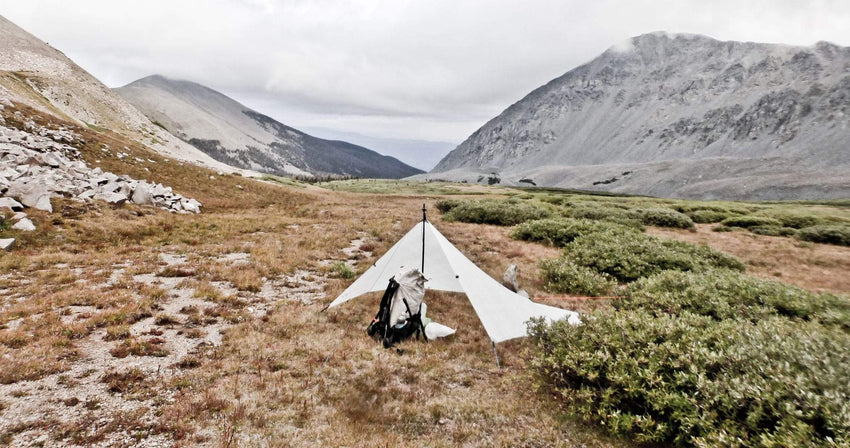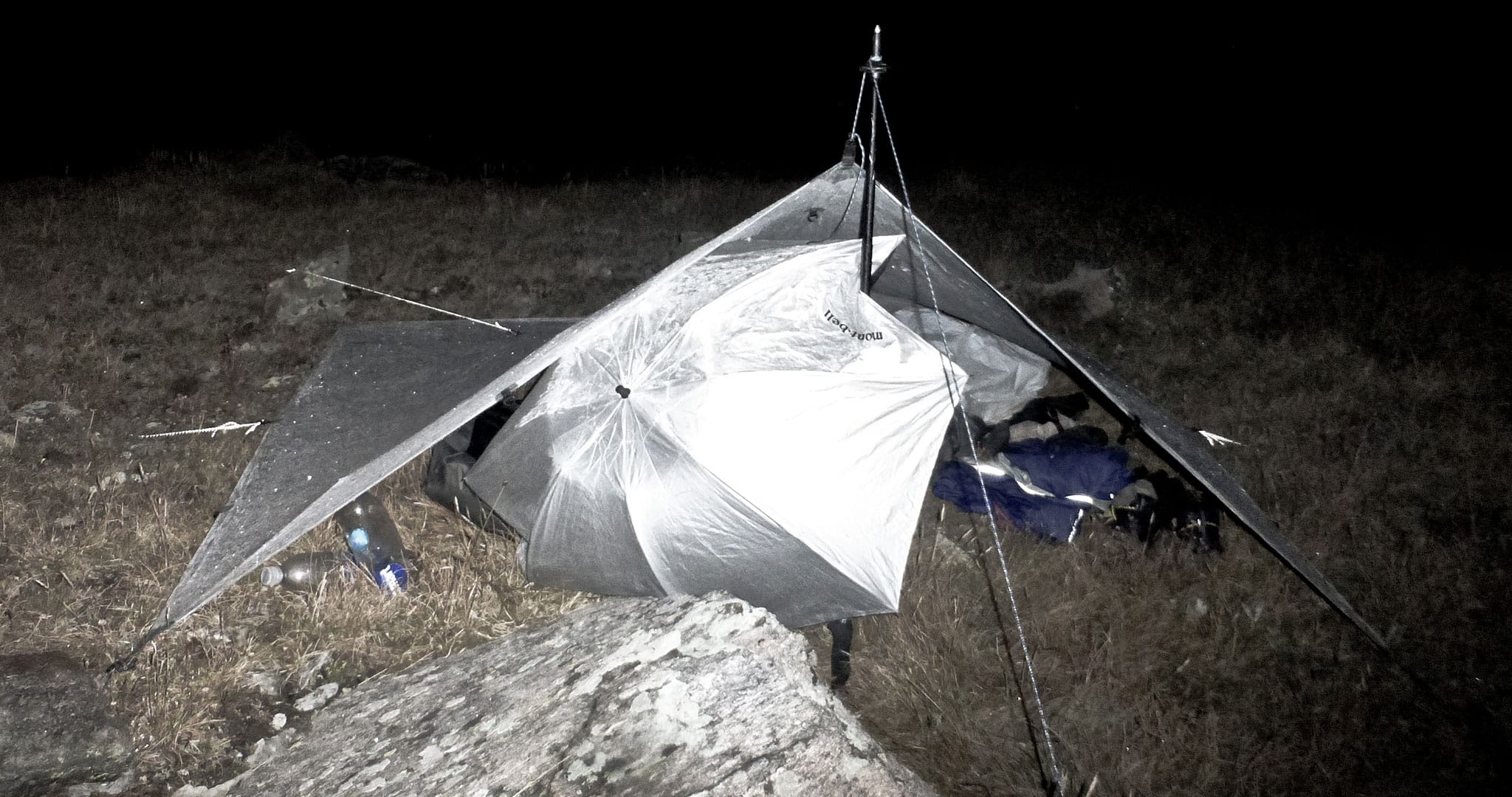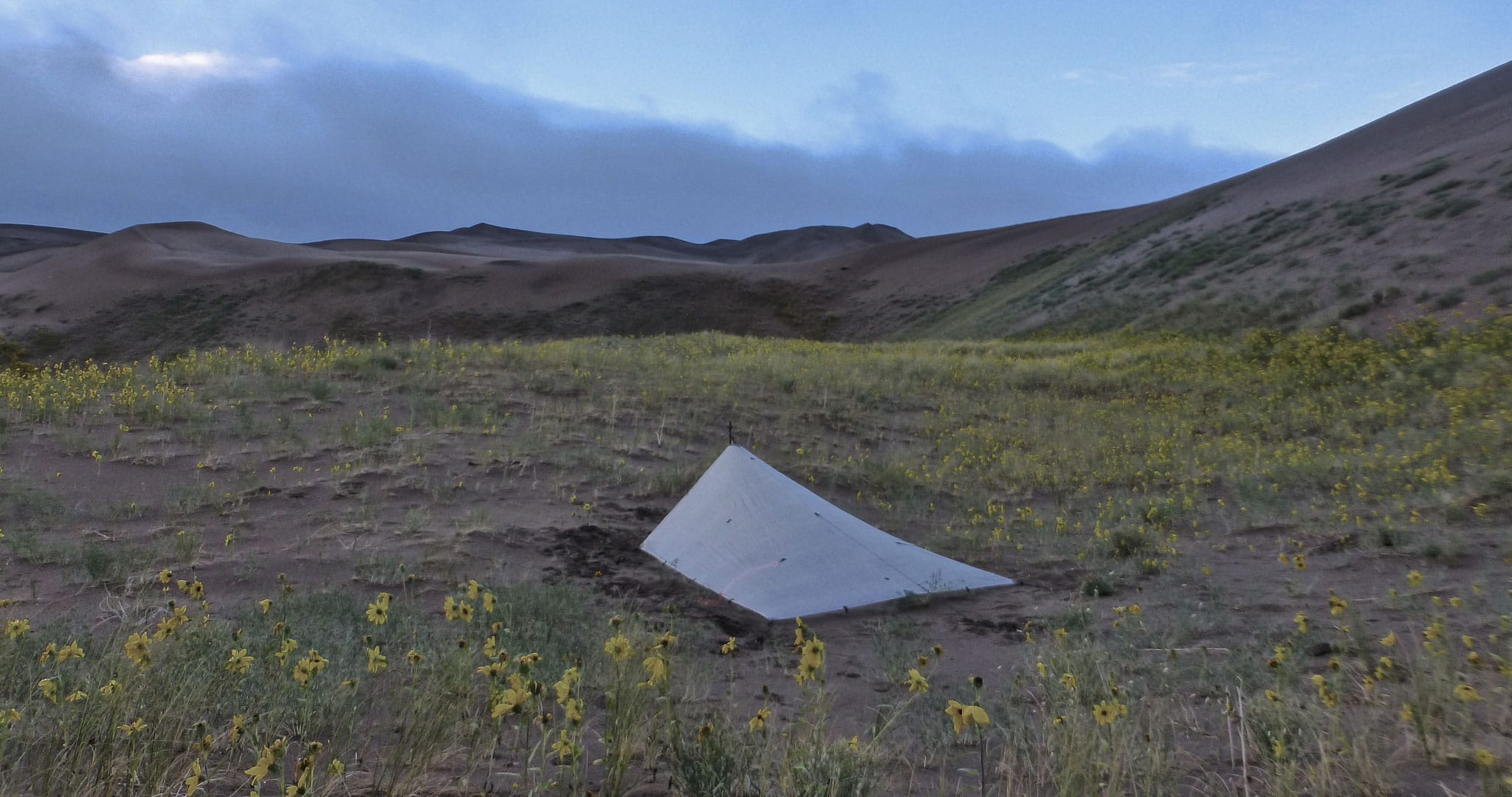Essential Tarp Camping

Words & Photos by Cam Honan
Nine Reasons to Try Tarp Camping
The essence of going lighter in the woods is not so much about gear, as it is about the adoption of a simpler, less cluttered approach to one’s time backpacking. Insofar as this philosophy relates to shelters, tarp camping fits the bill both tangibly and intangibly.
In the following article I’ll examine the benefits of tarp camping, as well as share some tips and techniques to minimize the perceived negatives. I’ll end the piece with an overview of environments in which the hiker is better off leaving the tarp at home, and going with a tent.
(1) Weight: Less materials mean that tarps are generally lighter than tents.
(2) Durability: Simpler designs equate to less that can catch, rip or break.
(3) Space: Tarps have the best space-to-weight ratio of all shelters.
(4) Versatility: Unlike tents, tarps can be pitched in a multitude of configurations depending on personal preference and the prevailing conditions. Not an insignificant factor, when you are hiking through areas in which potential campsites are few and far between.

(5) Ventilation: Less condensation issues than tents and bivy sacks.
(6) Less Expensive: Simpler design + less material = cheaper shelter.
(7) Nature’s Call: Sleeping under a tarp makes for an easier exit when you wake up at 2.35 am and you’re busting for a pee. No small thing for the chronologically challenged amongst us.
(8) Satisfaction: Being able to consistently achieve a taut pitch in a variety of configurations and environments, is a bushcraft skill that requires both practice as well as creativity (Note: The “inappropriate and droopy” setup is far easier to learn, and many hikers have been known to master it from the outset). However, once you have the hang of tarps, a rock solid pitch in challenging circumstances brings with it a certain sense of satisfaction; a bit like starting a fire in the rain or route finding with map and compass in rugged, off-trail terrain. Call it another arrow in your backcountry skill set quiver.

(9) Openness: The “open” nature of tarps helps to promote a heightened sense of connection with the wilderness. Zipping up and shutting out is not an option. If one of your goals when venturing out into the boonies is the diminishment of any “barriers”, be they tangible or intangible, that may exist between yourself and the natural world, shouldn’t the same principle apply equally during the evening, as much as it does over the course of a hiking day?

“Ok, ok… tarps may be spacious, light and relatively inexpensive, but come on man, what about tarp camping vs. bugs and rain?”
Sleeping under a tarp isn’t as uncomfortable as many hikers imagine. While there’s no denying that tarps don’t provide the all-around protection of tents, there are a number of tips and tricks that hikers can employ in order to minimize the influence of both insects and the elements:
Location:
- When hiking in buggy areas, look for campsites that are both breezy and not too close to water sources.
- Tarps are floorless (as opposed to ‘flawless’), so extra emphasis should be placed on finding sites with good drainage. Depressions, gullies and dished/overly-used campsites should be avoided if precipitation is on the cards.
- If you are hiking at high elevations your tarp camping options may be limited unless you are carrying poles. That being the case, it is essential to plan ahead. If inclement weather is a possibility, either drop below the trees or alternatively pick up one or two appropriately sized sticks with which to erect your shelter at day’s end. If descending below tree line is not an option, pitch your shelter as low and tautly as possible; an umbrella can be quite handy for insurance purposes if things turn nasty!

Noseeum Netting:
To combat bugs, bring along four or five feet of gossamer weight noseeum netting, which can be used in either of the following ways: (A) Attach it to a clip on the inside of your tarp and then tuck it under your sleeping bag, or; (B) Employ what well known Triple Crown hiker Lint Bunting calls a “bug condom” (i.e. Before going to sleep drape the netting over your hiking umbrella, then tuck it into the top of your bag).
Bivy:
Unless I’m hiking in areas where the chances of wet weather is almost non-existent, I’ll invariably combine my tarp with a lightweight bivy sack (weight – 7 oz) that has a built in bug net window*. In addition to keeping the insects at bay, the bivy adds five to ten degrees of warmth to my sleeping system, keeps the splash back off my quilt, negates the need for a groundsheet and provides a little extra protection against punctures for my inflatable sleeping mat. *Note: If you would prefer the bug net section not to be directly against your face, you can attach it to a clip on the inside of the tarp.

For two people (or a solo hiker that likes lots of space), 8’x10’ is a great size. Big enough to keep the rain out, but not so large that you need a small football field area in order to pitch it.
For lone hikers, opinions and preferences vary in regards to dimensions. Personally speaking, for rectangular tarps I like 6’ x 9’ or 7’ X 9’. For square tarps, I wouldn’t recommend going any smaller than 8.5’ x 8.5’ (Note: I’m 6’1”) or any larger than 9’ x 9’.

Tarp Camping vs. Ultralight Tents
As much as I love tarps, they by no means represent a panacea to all of your backcountry shelter needs. There are certain situations and environments in which I will invariably opt for a tent over a tarp.
For example:
- In consistently sub-freezing temperatures or in regions that are prone to extremely inclement weather (e.g. Southwest Tasmania, Fiordland and the Scottish Highlands).
- Peak season in über-buggy places such as Alaska, Lapland, Scotland and Fiordland. As fond as I am of the tarp/bivy combo mentioned above, it’s nice to have a little more breathing room when the mosquito/midge/sandfly wagons are circling at dawn and dusk.
- When hiking in developing countries. Over the years I’ve found it to be preferable not to have all my gear on display when bunking down in the vicinity of villages or nomadic encampments. Local people will invariably be curious as to the cost of backpacking equipment. The privacy of a tent helps in avoiding the inevitable question, “ how much does this cost?” Such queries can be uncomfortable, as they emphasize the discrepancy in material affluence between yourself and your hosts (Tip: In such situations, I generally try to deflect the question by indicating that the item was a gift from my family).

Cam Honan is an accomplished hiker who runs www.thehikinglife.com and as of 2016 has hiked more than 57,000 miles in some 56 countries across the globe.
The post Essential Tarp Camping appeared first on Hyperlite Mountain Gear Blog.